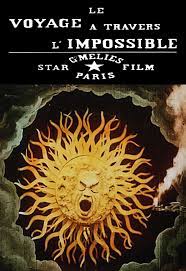
The members of the Institute of Incoherent Geography are planning a world tour. At the meeting are President Polehunter, Vice President Humbug, Secretary Rattlebrain, Archivist Mole as well as members Easily-fooled, Daredevil, Schemer and others. Professor Daredevil submits a travel plan but it is rejected as being done before and the President is looking for something more innovative and spectacular. Polehunter invites the eccentric engineer Crazyloff (Georges Melies) to the institute. Crazyloff proposes what he calls an impossible voyage using every new means of transportation possible. His plan includes trains, cars, a dirigible, and a submarine. The plan is accepted and preparations begin.
On the first leg of the journey the members board a train that takes them from Paris to the Swiss Alps. Included on the passenger list are the President’s and Crazyloff’s wives and the Institute’s servant Bob. They then board a touring car invented by Crazyloff called Auto-Crazyloff. While driving too fast over the mountains the car crashes and all the passengers end up in the hospital. When everyone is recovered they board a special train that speeds away and flies off into space. The train and passengers crash into the mouth of the sun. The sun is hot so Crazyloff puts everyone into an icebox car. Unfortunately everyone freezes solid so Crazyloff starts a fire to thaw the passengers out.
Crazyloff then ushers everyone into his submarine and they parachute through space and fall into an ocean on Earth. After touring around the ocean for awhile the submarine catches fire and explodes. Everyone lands safely in the nose of the submarine on a craggy shoreline. From there they all return to the Institute of Incoherent Geography in triumph. They do the dance of joy.
“The Impossible Voyage” AKA “Le Voyage a travers I’impossible”, AKA “Whirling the Worlds” in Britain, was released in 1904 and was directed by Georges Melies. It is a French silent science fiction fantasy film and is only about twenty minutes long. Melies did this film after this very popular “A Trip to the Moon” 1902. Although not as well known as his earlier work it is just as entertaining.
There are no intertitles in the film but an explanation of the story, written by Melies, appears in an English language catalog done by the producers of the film, the Star Film Company. The write-up, with pictures, is about eight pages long. The full title of the description is “An Impossible Voyage: An Incredible Expedition of a Group of Savants of the Institute of Incoherent Geography.” Some prints of the film were individually hand-colored. Sometime in the late twentieth century, a surviving hand-colored copy was donated to Melies’ family by the Czech Film Archive. Many of the prints of the film available now are colored by computer.
Many scholars have noted that “Impossible Voyage” is the opposite of “A Trip to the Moon”. They note several differences as examples. In “Trip” the passengers travel to the Moon and land on its surface. The journey is illustrated with the scenes moving left to right. In “Voyage” the passengers travel to the Sun and land inside it. The scenes during the journey are generally moving from right to left.
Melies did an epilogue to the film where the members of the institute confront Crazyloff for losing all of the special equipment they spent so much money making. Crazyloff creates a giant magnet that he aims at the heavens. The magnet pulls down the lost train, car and submarine. Everyone is happy and they once again do the dance of joy. The epilogue was believed to have been lost until the 1970s when John Frazer reportedly discovered and examined it in the archives of the Academy of Motion Picture Arts and Sciences. It was among surviving negatives from Star Film's New York offices. In 2008, however, Jacques Malthete, who wrote several books on Melies, has it still listed as lost. A print of the film, not the epilogue, was deposited for American copyright at the Library of Congress on October 12, 1904.
The film is an interesting little satire and a comment on Melies’ opinion of the upper class, especially their tendency to wreak havoc without regard for others.

